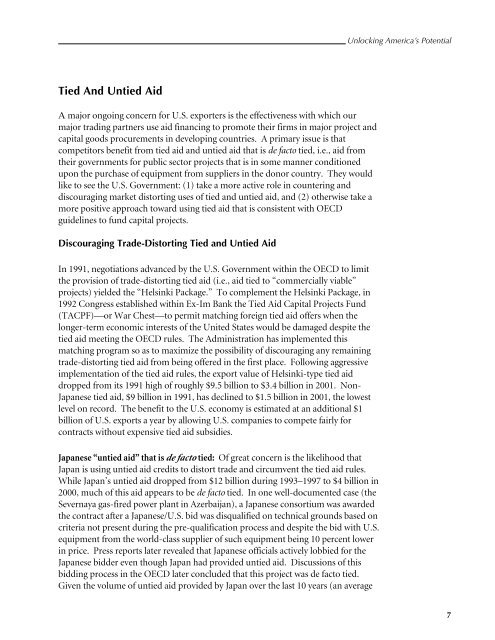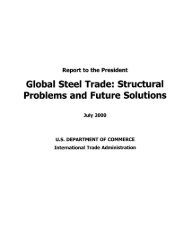National Export Strategy 2002 - International Trade Administration ...
National Export Strategy 2002 - International Trade Administration ...
National Export Strategy 2002 - International Trade Administration ...
You also want an ePaper? Increase the reach of your titles
YUMPU automatically turns print PDFs into web optimized ePapers that Google loves.
Unlocking America’s Potential<br />
Tied And Untied Aid<br />
A major ongoing concern for U.S. exporters is the effectiveness with which our<br />
major trading partners use aid financing to promote their firms in major project and<br />
capital goods procurements in developing countries. A primary issue is that<br />
competitors benefit from tied aid and untied aid that is de facto tied, i.e., aid from<br />
their governments for public sector projects that is in some manner conditioned<br />
upon the purchase of equipment from suppliers in the donor country. They would<br />
like to see the U.S. Government: (1) take a more active role in countering and<br />
discouraging market distorting uses of tied and untied aid, and (2) otherwise take a<br />
more positive approach toward using tied aid that is consistent with OECD<br />
guidelines to fund capital projects.<br />
Discouraging <strong>Trade</strong>-Distorting Tied and Untied Aid<br />
In 1991, negotiations advanced by the U.S. Government within the OECD to limit<br />
the provision of trade-distorting tied aid (i.e., aid tied to “commercially viable”<br />
projects) yielded the “Helsinki Package.” To complement the Helsinki Package, in<br />
1992 Congress established within Ex-Im Bank the Tied Aid Capital Projects Fund<br />
(TACPF)—or War Chest—to permit matching foreign tied aid offers when the<br />
longer-term economic interests of the United States would be damaged despite the<br />
tied aid meeting the OECD rules. The <strong>Administration</strong> has implemented this<br />
matching program so as to maximize the possibility of discouraging any remaining<br />
trade-distorting tied aid from being offered in the first place. Following aggressive<br />
implementation of the tied aid rules, the export value of Helsinki-type tied aid<br />
dropped from its 1991 high of roughly $9.5 billion to $3.4 billion in 2001. Non-<br />
Japanese tied aid, $9 billion in 1991, has declined to $1.5 billion in 2001, the lowest<br />
level on record. The benefit to the U.S. economy is estimated at an additional $1<br />
billion of U.S. exports a year by allowing U.S. companies to compete fairly for<br />
contracts without expensive tied aid subsidies.<br />
Japanese “untied aid” that is de facto tied: Of great concern is the likelihood that<br />
Japan is using untied aid credits to distort trade and circumvent the tied aid rules.<br />
While Japan’s untied aid dropped from $12 billion during 1993–1997 to $4 billion in<br />
2000, much of this aid appears to be de facto tied. In one well-documented case (the<br />
Severnaya gas-fired power plant in Azerbaijan), a Japanese consortium was awarded<br />
the contract after a Japanese/U.S. bid was disqualified on technical grounds based on<br />
criteria not present during the pre-qualification process and despite the bid with U.S.<br />
equipment from the world-class supplier of such equipment being 10 percent lower<br />
in price. Press reports later revealed that Japanese officials actively lobbied for the<br />
Japanese bidder even though Japan had provided untied aid. Discussions of this<br />
bidding process in the OECD later concluded that this project was de facto tied.<br />
Given the volume of untied aid provided by Japan over the last 10 years (an average<br />
7
















